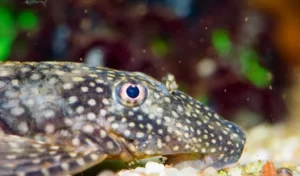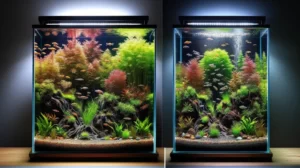
Rabbit Snail Care: Tank Requirements, Breeding & More

Writer at The Aquarium Keeper
Snails are an underappreciated option when it comes to aquarium pets. They can be really cool and one of the coolest freshwater snails is the Rabbit snail. Renowned for their rabbit-like appearance, they also have interesting behavior patterns, possess vibrant colors, and are relatively large compared to other snails. They are not as well-known as some of the other freshwater snails which is why, we will take a closer look at everything there is to know about these cute and awesome creatures in this rabbit snail care guide.
Rabbit Snail Etymology
The name “rabbit snail” is generally believed to be derived from the snail’s physical resemblance to a rabbit. While it doesn’t exactly look like a rabbit, there is a distant similarity in appearance once the snail is outside its shell. The scientific name of the rabbit snail is Tylomelania, which comes from the Greek words “tyloma” meaning “callus” or “thickening,” and “melaina” meaning “black.” This name possibly refers to the snail’s hard, dark-colored shell.
How do Rabbit Snails Look Like?
Rabbit snails are freshwater snails that belong to the family Pachychilidae. There are a lot of types of rabbit snails to choose from, each with its own unique shells and body color. They are relatively large snails, with adults growing to about 2-3 inches or 5-7.5 cm in length.
One of the defining features of rabbit snails is their somewhat unique shell shape. The shell is long and conical. It looks like a larger more elongated version of other freshwater snails such as assassin snails. The shell color can range from dark brown to light beige, with some species featuring intricate patterns or stripes.

Another distinctive feature of rabbit snails is their operculum, a hard plate that covers the opening of their shell. The operculum is brownish in color and helps protect the snail from predators and adverse environmental conditions. This operculum does not close completely as it does in some species like the Japanese Trapdoor Snail. Rabbit snails have muscular feet that they use to move around and attach to surfaces in the aquarium. Their tentacles are long and thin, with the eyes located at the base of the tentacles.
Rabbit Snail Natural Habitat
Rabbit snails are native to Southeast Asia, specifically in the regions of Thailand, Cambodia, and Laos. They can be found in rivers, streams, and other freshwater habitats in these regions. In their natural habitat, rabbit snails prefer slow-moving or stagnant water with a soft substrate, such as mud or sand. They are commonly found in water bodies near dense vegetation, such as forests, and are often seen burrowing into the substrate.
Rabbit snails are adapted to their natural environment and have evolved certain physical characteristics to survive in these habitats. For example, their long and slender shell shape allows them to burrow and move through the soft substrate, while their strong operculum helps protect them from predators. In the aquarium hobby, rabbit snails have become popular due to their unique appearance and their docile nature which makes them a great addition to a community tank.
Rabbit Snail Tank Setup
Rabbit snails are not that hard to take care of, and any beginner could easily do so. Although the aquarium has to be properly set up. Here are some of the things to keep in mind when setting up a tank for rabbit snails:
- Tank size – These are relatively large freshwater snails and require adequate space to move around. A minimum tank size of 15 gallons is recommended for a small group of 3-4 rabbit snails. You can keep 1 rabbit snail per 5 gallons.
- Substrate – A soft substrate, such as sand or fine gravel, is ideal for rabbit snails. It allows them to burrow and dig into the substrate. They also move easier on the sand, compared to gravel substrate.
- Decor – Rabbit snails enjoy having hiding places and objects to climb on, such as driftwood, rocks, and plants. Live plants provide additional benefits, such as oxygenation and water filtration. Even though these snails are herbivores, they are plant-safe.
- Lighting – Moderate lighting is ideal for a rabbit snail tank.
- Water quality – As mentioned before, maintaining consistent water quality is essential for rabbit snails. Proper filtration and regular water changes are necessary to keep the water clean and healthy for the snails.
- Cover – Even though Rabbit Snails aren’t the best escape artists out there, they will escape the tank if there is a large enough opening. Provide a good-quality lid without any gaps to avoid any mishaps.
With a properly set up tank and good care, rabbit snails can thrive and live for up to 3 years and even exceed that in some cases.
Ideal Water Parameters For Rabbit Snails
While Rabbit Snails are relatively hardy, providing them with a stable environment will go a long way in keeping them healthy and disease-free. Here are the ideal water parameters for rabbit snails:
- pH – Rabbit snails prefer slightly alkaline water with a pH range between 7.5-8.5. Acidic water can adversely affect their shells making them weak and brittle.
- Temperature – The optimal temperature range for rabbit snails is 76-82°F or 24.5-28°C. Sudden changes in temperature can stress the snails and make them vulnerable to diseases and infections.
- Hardness – Rabbit snails prefer moderately hard water with a hardness range between 6-12 dGH.
- Ammonia, Nitrite, and Nitrate – Like most aquatic creatures, Rabbit Snails are sensitive to ammonia and nitrite. Nitrate levels should also be kept under control and below 20 ppm. Make sure that the tank is properly cycled before adding these snails.
- Oxygenation and filtration – Rabbit snails require well-aerated water with good water flow to maintain healthy oxygen levels and remove waste and debris from the tank. A good filtration system, as a result, is indispensable.
Even though rabbit snails can thrive in a relatively wide range of water conditions, they don’t like sudden water parameter changes. This can harm, and even kill your snail. Dead snails can then cause a lot of problems for your aquarium.
Rabbit Snail Diet
Rabbit snails are primarily herbivores, and they will graze on algae and other plant matter in the aquarium. They also enjoy fresh vegetables, such as zucchini, cucumber, and spinach. Supplement their diet with commercial snail food and sinking algae wafers. Even though these species are mainly herbivores, they sometimes will eat fish food or even deceased tank mates.
Rabbit Snail Tank Mates
Rabbit snails are very peaceful and apart from their shell, their body is very delicate. Tankmates should have a similar disposition. Any fish that constantly picks on snails should be avoided as they will stress out the snails which can drastically reduce their lifespan. Here are some great tankmates for Rabbit Snails.
- Guppies – These colorful and active fish are a popular choice for community tanks and make great tankmates for rabbit snails. They are peaceful and non-aggressive, and their small size makes them a good match for the relatively slow-moving rabbit snails.
- Neocaridina shrimp – These tiny and vibrant freshwater shrimp are another great tankmate option for rabbit snails. They are peaceful and will not harm or harass the snails. They also help keep the tank clean by eating algae and leftover food. You can also choose from a wide range of neocaridina shrimp colors, and find the best-looking shrimp for your snails.
- Corydoras catfish – These small and social catfish are a popular choice for community tanks and are compatible with rabbit snails. They are bottom-dwellers and will not compete with the snails for food or space.
- Neon tetras – These small and colorful fish are peaceful and active, making them great tankmates for rabbit snails. They are also relatively small and will not outcompete or harm the snails.
- Mystery snails – These large and peaceful freshwater snails are compatible with rabbit snails and make for great pets on their own. There are a lot of mystery snail colors to choose from, so find one, that would look best with your rabbit snails.
Some other great options include tetras that can tolerate an alkaline environment, platies, mollies, rasboras, and Japanese rice fish. Aggressive or territorial fish, such as cichlids should not be housed with rabbit snails, as they may harm or stress out the snails. Additionally, rabbit snails may be vulnerable to attack from large and predatory fish, such as pufferfish which love to eat shelled animals.
Rabbit Snail Breeding
Most freshwater snails are notorious for being prolific breeders and more often than not, it is controlling their population which is a bigger concern than getting them to breed. Rabbit Snails buck this trend as they don’t breed that readily.
Rabbit snails are able to mate once they are a year old and under the right conditions, they will breed only every 6 weeks. They also breed in very small numbers. Each breeding cycle only results in a couple of baby snails. Here are the steps involved in successfully breeding these snails:
- Male and female identification – Rabbit snails are hermaphrodites, meaning they have both male and female reproductive organs. However, they still require a mate to reproduce. Make sure there are at least 4 individuals in the tank.
- Tank setup – To encourage breeding, provide your rabbit snails with a spacious and well-aerated tank that mimics their natural environment. Use soft and sandy substrate to allow the snails to burrow and lay their egg sac. Add plenty of hiding spots, such as rocks or driftwood, and avoid aggressive tankmates that may harm or stress out the snails.
- Water parameters – Rabbit snails prefer slightly alkaline water with a pH between 7.5-8.5 and a temperature range of 76-82°F or 24.5-28°C. Choose a value somewhere in the middle and keep the conditions as stable as possible.
- Courtship and mating – Rabbit snails engage in a bit of courtship before mating, which involves circling each other and extending their bodies towards each other. Once a pair is ready to mate, one of the snails will transfer sperm to the other which will then release a white egg sack containing one or two baby snails.
- Incubation and hatching – The young will typically emerge from the egg sac within a week. The hatchlings come out as miniature versions of their parents and require the same water parameters and diet as adult snails.
- Caring for the young – As long as there aren’t any large fish, the baby snails won’t need any special attention. They will be able to fend for themselves. Separate the young into a grow-out tank if there are fish with mouths large enough to eat the baby snails.
Rabbit Snail Common Diseases And Treatments
Rabbit snails are generally hardy and resistant to disease, but they can still be susceptible to certain ailments if their environment or diet is not great. Here are some common diseases that can affect rabbit snails:
- Shell damage – Rabbit snails can sometimes develop cracks, chips, or holes in their shells, which can be caused by physical damage or poor water quality. If left untreated, shell damage can lead to infections and even death. Treatment involves improving water quality, providing a calcium-rich diet, and in extreme cases, applying a shell repair solution to the damaged area and hoping for the best.
- Parasites – They can be affected by various external and internal parasites. Leeches are a common issue in wild-caught specimens. Symptoms may include lethargy, loss of appetite, abnormal behavior, and visible signs of parasites on the snail’s body. Treatment involves using a salt bath for 12-24 hours.
- Nutritional deficiencies – Rabbit snails require a well-balanced diet that is rich in calcium. A poor diet can lead to inadequate growth, weakened shells, and other health problems. Treatment involves adjusting their diet to ensure they are getting all the necessary nutrients.
- Reaction To Metals –These snails don’t do all too well if there is copper or rust in the water. If the fish seem fine while all the snails and any other crustacean in the tank seem sick then there is a high likelihood of there being traces of metal in the water. Perform a large water change. Remove anything with rust in the tank and avoid medication with copper in it.
Frequently Asked Questions
Do Rabbit Snails Require Any Special Care?
Rabbit snails require a well-maintained aquarium with good water quality and a balanced diet. They may also benefit from occasional supplementation with calcium to promote shell health.
Do Rabbit Snails Breed Easily?
Rabbit snails have a slower reproduction rate compared to other snail species. They reach sexual maturity after 1 year and they each breeding cycle of 4-6 weeks only produces one or two baby snails.
Writer's Thoughts
Rabbit snails are quite unique when compared to other freshwater snails. They have been becoming popular in the aquarium hobby in recent times due to their unique appearance and peaceful nature. They are herbivores that feed on algae and other plant materials and can coexist with most small and docile freshwater aquarium fish and invertebrates.
Rabbit snails have a slower reproduction rate compared to other snail species, and they require a well-maintained aquarium with good water quality and a balanced diet. With proper care, rabbit snails can make a beautiful and interesting option for any aquarium enthusiast looking for something beyond the norm.
If you enjoyed reading this article please feel free to share it with your friends by clicking the social media buttons below:





